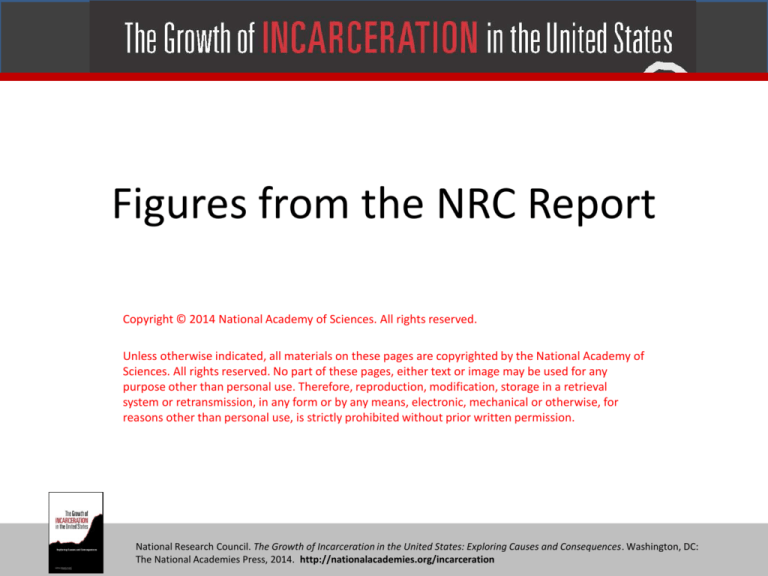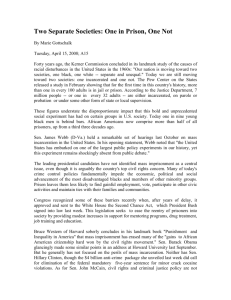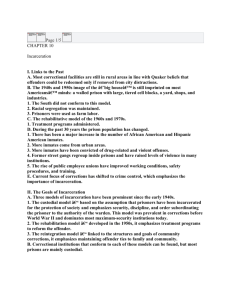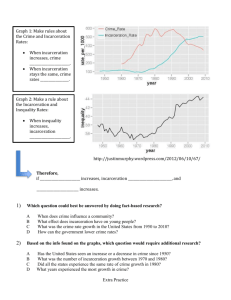
Figures from the NRC Report
Copyright © 2014 National Academy of Sciences. All rights reserved.
Unless otherwise indicated, all materials on these pages are copyrighted by the National Academy of
Sciences. All rights reserved. No part of these pages, either text or image may be used for any
purpose other than personal use. Therefore, reproduction, modification, storage in a retrieval
system or retransmission, in any form or by any means, electronic, mechanical or otherwise, for
reasons other than personal use, is strictly prohibited without prior written permission.
National Research Council. The Growth of Incarceration in the United States: Exploring Causes and Consequences. Washington, DC:
The National Academies Press, 2014. http://nationalacademies.org/incarceration
FIGURE 1-1 U.S. crime and imprisonment rates, 1960-2010.
NOTE: The different crime rates have been rescaled, as noted in the figure to facilitate comparison of time trends.
SOURCE: Tonry, M. (2012, April 26). Sentencing. Presentation to the Robina Institute Annual Conference, Crime and
Justice in America, 1975-2025. Minneapolis, MN.
National Research Council. The Growth of Incarceration in the United States: Exploring Causes and Consequences. Washington, DC:
The National Academies Press, 2014. http://nationalacademies.org/incarceration
900
800
Incarceration per 100,000
700
600
Prison and Jail
500
400
300
200
100
Prison only
year
1929
1934
1939
1944
1949
1954
1959
1964
1969
1974
1979
1984
1989
1994
1999
2004
2009
0
FIGURE 2-1 U.S. state and federal imprisonment rate (1925-2012) and total incarceration including prison
and jail inmates (1972-2012) per 100,000 residents.
SOURCES: Maguire, K. (Ed.). (n.d.). Sourcebook of Criminal Justice Statistics Online. Albany, NY: University at
Albany, Hindelang Criminal Justice Research Center. Available: http://www.albany.edu/sourcebook [June
2013]; and for 2012 figures, Glaze, L.E., and Herberman, E.J. (2013). Correctional Populations in the United
States, 2012. Washington, DC: U.S. Department of Justice, Bureau of Justice Statistics and U.S. Census
Bureau. (n.d.). U.S. and World Population Clock. Available: http://www.census.gov/popclock/ [January 17,
2014]
National Research Council. The Growth of Incarceration in the United States: Exploring Causes and Consequences. Washington, DC:
The National Academies Press, 2014. http://nationalacademies.org/incarceration
International Comparisons
United States
707
Russian Federation
474
Ukraine
286
Poland
209
Turkey
188
Hungary
186
Czech Republic
157
United Kingdom (England & Wales)
148
Spain
145
Portugal
137
Australia
133
Canada
118
Greece
111
Belgium
108
Italy
105
France
100
Austria
98
Netherlands
82
Switzerland
82
Germany
77
Denmark
73
Norway
72
Sweden
67
Finland
58
0
50
100 150 200 250 300 350 400 450 500 550 600 650 700 750
FIGURE 2-2 Incarceration rates per 100,000 population of European and selected common law countries.
NOTES: Rate estimates vary slightly from those of other sources for the United States. Year of reporting for
the United States is 2012; years for other nations range from 2011 to 2013.
SOURCE: International Centre for Prison Studies. (2013). World Prison Brief. Available:
http://www.prisonstudies.org/world-prison-brief [January 2014].
National Research Council. The Growth of Incarceration in the United States: Exploring Causes and Consequences. Washington, DC:
The National Academies Press, 2014. http://nationalacademies.org/incarceration
FIGURE 2-3 Percentage growth in federal and state prison populations and the local jail population by
decade, 1972 to 2010.
NOTE: Growth is measured as the percentage change from 1972 to 1980, from 1981 to 1990, from 1991 to
2000, and from 2001 to 2010.
National Research Council. The Growth of Incarceration in the United States: Exploring Causes and Consequences. Washington, DC:
The National Academies Press, 2014. http://nationalacademies.org/incarceration
FIGURE 2-4 Total adult correctional population, including state and federal prison, local jail, and probation
and parole populations, 1972 to 2010.
SOURCE: Maguire, K. (Ed.). (n.d.). Sourcebook of Criminal Justice Statistics Online. Albany, NY: University at
Albany, Hindelang Criminal Justice Research Center. Available: http://www.albany.edu/sourcebook [June
2013].
National Research Council. The Growth of Incarceration in the United States: Exploring Causes and Consequences. Washington, DC:
The National Academies Press, 2014. http://nationalacademies.org/incarceration
FIGURE 2-5 Change in state imprisonment rates per 100,000 population, 50 states, 1972-2000 and 2000-2010.
SOURCE: Sourcebook of Criminal Justice Statistics (1982) and Maguire, K. (Ed.). (n.d.). Sourcebook of Criminal
Justice Statistics Online. Albany, NY: University at Albany, Hindelang Criminal Justice Research Center.
Available: http://www.albany.edu/sourcebook [June 2013].
National Research Council. The Growth of Incarceration in the United States: Exploring Causes and Consequences. Washington, DC:
The National Academies Press, 2014. http://nationalacademies.org/incarceration
FIGURE 2-6 Violent and property crime rates per 100,000 population, 1960 to 2011, and the drug arrest rate
per 100,000, 1980 to 2010.
SOURCES: Uniform Crime Reports. Drug crime rate, 1965-1980; Federal Bureau of Investigation. (1993).
Age-Specific Arrests Rates and Race-Specific Arrests Rates for Selected Offenses, 1965-1992. Washington,
DC: U.S. Department of Justice, Uniform Crime Reporting Program; Maguire, K. (Ed.). (n.d.). Sourcebook of
Criminal Justice Statistics Online. (Table 3.1062.2011, property and violent crime rates) Albany, NY:
University at Albany, Hindelang Criminal Justice Research Center. Available:
http://www.albany.edu/sourcebook [June 2013]; and Uniform Crime Reports (drug arrest rates).
National Research Council. The Growth of Incarceration in the United States: Exploring Causes and Consequences. Washington, DC:
The National Academies Press, 2014. http://nationalacademies.org/incarceration
FIGURE 2-7 Combined state incarceration rate by crime type, 1980 to 2010.
SOURCE: Beck, A.J., and Blumstein, A. (2012, October 31). Trends in Incarceration Rates: 1980-2010. Paper
prepared for the National Research Council Committee on the Causes and Consequences of High Rates of
Incarceration, Washington, DC.
National Research Council. The Growth of Incarceration in the United States: Exploring Causes and Consequences. Washington, DC:
The National Academies Press, 2014. http://nationalacademies.org/incarceration
FIGURE 2-8 Arrests per 100 adult offenses by crime type, 1980 to 2010.
SOURCE: Beck, A.J., and Blumstein, A. (2012, October 31). Trends in Incarceration Rates: 1980-2010. Paper
prepared for the National Research Council Committee on the Causes and Consequences of High Rates of
Incarceration, Washington, DC.
National Research Council. The Growth of Incarceration in the United States: Exploring Causes and Consequences. Washington, DC:
The National Academies Press, 2014. http://nationalacademies.org/incarceration
FIGURE 2-9 State prison admissions per 100 adult arrests, 1980-2010.
SOURCE: Beck, A.J., and Blumstein, A. (2012, October 31). Trends in Incarceration Rates: 1980-2010. Paper
prepared for the National Research Council Committee on the Causes and Consequences of High Rates of
Incarceration, Washington, DC.
National Research Council. The Growth of Incarceration in the United States: Exploring Causes and Consequences. Washington, DC:
The National Academies Press, 2014. http://nationalacademies.org/incarceration
FIGURE 2-10 Estimated time served in state prison, 1980 to 2010.
NOTE: See text for a discussion of calculations of time served.
SOURCE: Beck, A.J., and Blumstein, A. (2012, October 31). Trends in Incarceration Rates: 1980-2010. Paper prepared
for the National Research Council Committee on the Causes and Consequences of High Rates of Incarceration,
Washington, DC.
National Research Council. The Growth of Incarceration in the United States: Exploring Causes and Consequences. Washington, DC:
The National Academies Press, 2014. http://nationalacademies.org/incarceration
FIGURE 2-11 State and federal prison admission rates, 1926 to 1986, and state and federal imprisonment
rates, 1980 to 2010, for blacks and whites.
NOTES: A smooth line indicates the trend. Hispanics are included among both racial groups.
SOURCES: Admissions rates are from Langan, P.A. (1991). Race of Prisoners Admitted to State and Federal
Institutions, 1926-86. NCJ-125618. Washington, DC: U.S. Department of Justice, Bureau of Justice Statistics.
Black and white imprisonment rates are from Beck, A.J., and Blumstein, A. (2012, October 31). Trends in
Incarceration Rates: 1980-2010. Paper prepared for the National Research Council Committee on the Causes
and Consequences of High Rates of Incarceration, Washington, DC.
National Research Council. The Growth of Incarceration in the United States: Exploring Causes and Consequences. Washington, DC:
The National Academies Press, 2014. http://nationalacademies.org/incarceration
FIGURE 2-12 Average percentage of blacks among total arrests for murder and non-negligent manslaughter,
robbery, forcible rape, and aggravated assault, by decade, 1972 to 2011.
SOURCE: Uniform Crime Reports race-specific arrest rates, 1972 to 2011.
National Research Council. The Growth of Incarceration in the United States: Exploring Causes and Consequences. Washington, DC:
The National Academies Press, 2014. http://nationalacademies.org/incarceration
FIGURE 2-13 Drug arrest rates for blacks and whites per 100,000 population, 1972 to 2011.
SOURCES: Uniform Crime Reports race-specific arrest rates, 1980 to 2011 (accessed from BJS). 1972 to 1979
is taken from Federal Bureau of Investigation. (1990). Age-Specific Arrests Rates and Race-Specific Arrests
Rates for Selected Offenses, 1965-1988. NCJ 122713. Washington, DC: U.S. Department of Justice, Uniform
Crime Reporting Program.
National Research Council. The Growth of Incarceration in the United States: Exploring Causes and Consequences. Washington, DC:
The National Academies Press, 2014. http://nationalacademies.org/incarceration
FIGURE 2-14 Prison and jail incarceration rates per 100,000 population for non-Hispanic whites, nonHispanic blacks, and Hispanics, aged 18 to 64, 1972-2010.
SOURCE: See Appendix B of the 2014 NRC report The Growth in Incarceration in the United States.
National Research Council. The Growth of Incarceration in the United States: Exploring Causes and Consequences. Washington, DC:
The National Academies Press, 2014. http://nationalacademies.org/incarceration
FIGURE 2-15 Prison and jail incarceration rates for men aged 20-39 by education and race/ethnicity, 1972
and 2010.
NOTES: C = at least some college; HS = all noncollege men; DO = less than 12 years of completed schooling.
SOURCE: See Appendix B of the 2014 NRC report The Growth in Incarceration in the United States.
National Research Council. The Growth of Incarceration in the United States: Exploring Causes and Consequences. Washington, DC:
The National Academies Press, 2014. http://nationalacademies.org/incarceration
FIGURE 2-16 Cumulative risks of imprisonment by 1979 for men born in 1945-1949 and by 2009 for men
born in 1975-1979, by race and education.
NOTES: C = at least some college; HS = completed high school or general equivalency diploma (GED); DO =
no high school diploma or GED.
SOURCE: Data from Pettit, B., Sykes, B., and Western, B. (2009). Technical Report on Revised Population
Estimates and NLSY-79 Analysis Tables for the Pew Public Safety and Mobility Project. Table 37. Cambridge,
MA: Harvard University.
National Research Council. The Growth of Incarceration in the United States: Exploring Causes and Consequences. Washington, DC:
The National Academies Press, 2014. http://nationalacademies.org/incarceration
1,800,000
1,600,000
1,400,000
1,200,000
Children with incarcerated fathers
1,000,000
Fathers in prison
800,000
Children with incarcerated
mothers
600,000
Mothers in prison
400,000
200,000
1991
1997
1999
2004
2007
Year
FIGURE 9-1 Estimated number of parents in state and federal prisons and their minor children, by inmate’s
gender.
SOURCE: Data from Glaze, L.E., and Maruschak, L.M. (2008). Parents in Prison and Their Minor Children. NCJ
222984. Washington, DC: U.S. Department of Justice, Bureau of Justice Statistics.
National Research Council. The Growth of Incarceration in the United States: Exploring Causes and Consequences. Washington, DC:
The National Academies Press, 2014. http://nationalacademies.org/incarceration
FIGURE 10-1 Distribution of
incarceration in New York City
(2009). People admitted to prison
per 1000 adults by census tract of
residence with community district
borders.
NOTE: About half (52 percent) of
the people sent to prison from New
York City in 2009 came from 15 of
the city’s 65 community districts.
These 15 community districts have
the highest prison admission rates
among the city’s community
districts and are labeled on the map
according to rank from 1 to 15. They
are collectively labeled “Highest
(15)” and compared with the city’s
remaining 50 community districts,
labeled “Remaining (50),” in the
figure above.
SOURCE: Prepared for the
committee by The Justice Mapping
Center, Rutgers University School of
Criminal Justice: Maps designed and
produced by Eric Cadora and
Charles Swartz.
National Research Council. The Growth of Incarceration in the United States: Exploring Causes and Consequences. Washington, DC:
The National Academies Press, 2014. http://nationalacademies.org/incarceration
FIGURE 10-2 Distribution of
incarceration in Houston, Texas
(2008). People admitted to prison per
1000 adults by census tract of
residence with super neighborhood
borders.
NOTE: About half (52 percent) of the
people sent to prison from Houston
in 2008 came from 32 of the city’s 88
super neighborhoods. These 32 super
neighborhoods have the highest
prison admission rates among the
city’s super neighborhoods and are
labeled on the map according to rank
from 1 to 32. They are collectively
labeled “Highest (32)” and compared
with the city’s remaining 56 super
neighborhoods, labeled “Remaining
(50),” in the figure above.
SOURCE: Prepared for the committee
by The Justice Mapping Center,
Rutgers University School of Criminal
Justice: Maps designed and produced
by Eric Cadora and Charles Swartz.
National Research Council. The Growth of Incarceration in the United States: Exploring Causes and Consequences. Washington, DC:
The National Academies Press, 2014. http://nationalacademies.org/incarceration
Corrections Spending by Govt Level 1980-2010 (adjusted to 2011 dollars)
$60,000.00
Adjusted Spending (in millions of dollars)
$50,000.00
State
$40,000.00
Local
Federal
$30,000.00
$20,000.00
$10,000.00
$0.00
Year
FIGURE 11-1 Trends in state, local, and federal spending for corrections, 1980-2010.
NOTE: Amounts shown are adjusted to 2011 dollars.
SOURCE: Data from U.S. Census Bureau. (n.d.-a). Federal, State, and Local Governments. Available:
http://www.census.gov/govs/ and http://www2.census.gov/pub/outgoing/govs/special60/ [February 1,
2014].
National Research Council. The Growth of Incarceration in the United States: Exploring Causes and Consequences. Washington, DC:
The National Academies Press, 2014. http://nationalacademies.org/incarceration








